|
|
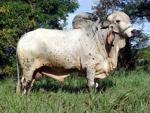
|
Gyr (Gur, Gir)
|
|
The Gyr is a medium to medium large animal, depending on whether they were developed in the Gyr valley region or in the surrounding mountain area. They can be either spotted (very fine spotting similar to roan in shorthorn) or rich red with varying degrees of the two combined. |
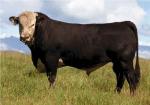
|
Hays Converter
|
|
The Hays Converter was developed by Senetor Harry Hays of Calgary, Canada in the mid 1970's. |
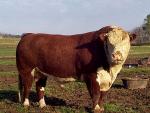
|
Hereford
|
|
Herefords are an ancient breed, kept in Herefordshire in western England for centuries. They gained their modern appearance around 1800 by crossing with cattle from Flanders. Originally, Herefords were large framed draught cattle, some weighing over 3,000 pounds. |
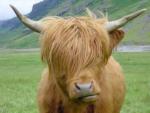
|
Highland
|
|
Highland cattle were developed in the western Highlands of Scotland and the outlying islands. This breed has remained unchanged for the last 200 years. The Highland Cattle Breed Society was founded in 1884 with the first herd book animals registered in 1885. |
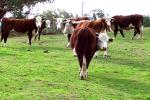
|
Hybridmaster
|
|
Hybridmaster cows are a strain of good fleshing, long, straight-muscled cattle with good grass capacity. |
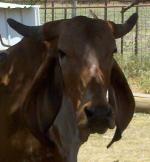
|
Indu-Brazilian
|
|
You can't miss the ears! The Indo-Brazilian's extremely long, large, pendulous ears make it easy to identify. |
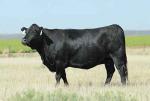
|
Irish Black
|
|
The Irish Black herd books were closed in 1971. All of the living animals of the breed trace directly back to five daughters of the first foundation bull. Irish Blacks are 99.98% pure Friesian blood. |

|
Limouisin
|
|
Limousin is a very old breed; it may have originated anywhere from 16000 to 13000 years ago as dated by cave drawings in the French Lascaux Cave. It was developed in the central Marche and Limousin regions of southern France. The area is relatively isolated and the cattle breed was allowed to grow with little to no external influences. Due to its environment, the Limousin attained superlative hardiness and adaptability. |
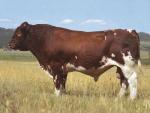
|
Maine-Anjou
|
|
Maine-Anjou originated in the northwestern part of France. The Maine-Anjou name comes from the Maine and Anjou river valleys. |
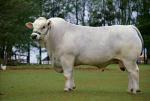
|
Marchigiana
|
|
The Marchigiana hair coat is white. Calves are fawn or wheat colored at birth and will turn white at 3 to 4 months. They have pronounced black skin pigmentation. The tongue, muzzle, and orifices are black. The switch of the tail and area around the eyes has dark, almost black, hair. |
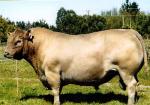
|
Murray Grey
|
|
The Murray Grey breed was evolved in the upper Murray River region in southern New South Wales, Australia in the early part of this century. The first gray cattle resulted from the mating of an Angus bull and a roan Shorthorn cow. |
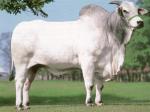
|
Nelore
|
|
Nelore are a type of Zebu cattle that are very popular in South America. Brazil is the largest breeder of Nelore. They are hardy cattle well suited for tropical or sub-tropical areas. Their loose black skin is covered by a white or light gray coat which filters and reflects harmful sun rays. |
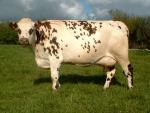
|
Normande
|
|
Normande is a dual purpose breed from the Normandy coastal area of France. They are tri-colored cattle with a dished face, short horns, large chest and big udders. They are known for a quiet temperament, ease of calving and handling and the ability to convert grass into milk. |

|
Piedmontese
|
|
Piedmontese are from the Piedmont Mountain area of northern Italy. They are thought to be the product of two distinct breeds - the Auroch and the Zebu - fused and evolved over 25,000 years of natural selection to become the Piedmontese breed. |

|
Pinzgauer
|
|
Pinzgauer were developed in the "Pinzgau" district in the province of Salzburg, Austria, and appear for the first time in documents in the 1600's. |
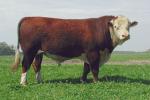
|
Polled Hereford
|
|
Herefords are an ancient breed, kept in Herefordshire in western England for centuries. They gained their modern appearance around 1800 by crossing with cattle from Flanders. Originally, Herefords were large framed draught cattle, some weighing over 3,000 pounds. During the nineteenth century there was selective breeding for early maturity, which entailed a reduction in the size of the frame. The first herd book was published in 1846, and later adopted by the 'Hereford Herd Book Society', founded in 1878. |

|
Red Angus
|
|
The Red Angus breed originated in the British Isles and recorded reference to the appearance of red cattle dates back to 1805. |
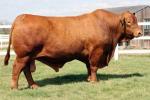
|
Red Brangus
|
|
The blend of 3/8 Brahman and 5/8 Red or Black Angus is the internationally accepted combination of a purebred Red Brangus and Brangus. Red Brangus Cattle have genetics that are ideal for tropical and sub-tropical regions of the world. Red Brangus Cattle combine the hardiness, disease resistance and unmatched maternal instincts of the Brahman breed with the superior carcass quality, fertility, maternal and milking ability of the Angus. Red Brangus calves are small at birth, averaging 70 to 75 pounds, but yield high weaning weights. These calves continue to gain efficiently in the feedlot and yield the lean and tasty Yield Grade 2, Choice carcasses the consumer demands. |

|
Red Poll
|
|
Red Poll Cattle were developed in England from two ancient breeds - the Norfolk and Suffolk. The resulting cattle were selected for both meat and milk qualities and became very popular as a dual purpose breed producing both good quality milk and beef. Red Poll offspring are highly predictable and uniform. Because they are only distantly related to many other commercial beef breeds, the Red poll can impart significant hybrid vigor when crossed with other breeds. Red Polls were used in the development of the Senopol breed in the Caribbean beginning in the 1920's |

|
Romagnola
|
|
Developed in Italy's Po Valley by the crossing of Podolic cattle with indigenous strains. They were consolidated in the nineteenth century in the province of Forli. They were crossed with Chianina during the period 1850-80. At the world exhibition in Paris in 1900 the Romagnola was distinguished as the best beef breed. A herd book was opened in 1956. |
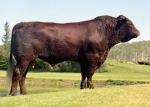
|
Salers
|
|
Drawings of Salers (say Sa'lair) were discovered by archaeologists in cave dwellings dated some 7,000 years ago. The drawings were found near Salers, a small medieval town in the center of France. These drawings and the Salers cattle of today, which are very different from all other French breeds, bear some resemblance to the ancient Egyptian red cattle. |
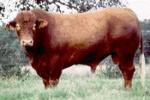
|
Santa Cruz
|
|
Santa Cruz cattle represent over ten years of intense research and development by the King Ranch aimed at creating a more market acceptable beef animal that produced superior results as both a feeder and seedstock animal in hot, humid, and unfavorable environments. |
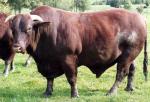
|
Santa Gertrudis
|
|
Santa Gertrudis were developed on King Ranch to function in hot, humid, and unfavorable environments. The Santa Gertrudis was developed by crossing Indian Brahman cattle with British Shorthorns. In 1920, years of experimentation culminated with the birth of Monkey, a deep red bull calf. Monkey became the foundation sire for not just a superior line of cattle, but an entirely new breed. In 1940, Santa Gertrudis was recognized by the U.S. |
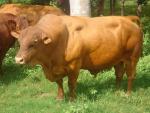
|
Senepol
|
|
Senepol were developed on the Caribbean Island of St. Croix by Henry C. Nelthropp in the early 1900's by crossing Red Poll cattle and N'Dama cattle. The Senepol breed combines the N'Dama characteristics of heat tolerance and insect resistance with the extreme gentleness, good meat, and high milk production of the Red Poll. He selected for early maturity and maternal efficiency, no horns and solid red color, definite heat tolerance, and gentle disposition. |

|
Shorthorn
|
|
Shorthorn originated Tees River Valley in the northeastern part of England in the counties of Northumberland, Durham, York and Lincoln. They were brought to America in 1783 and were popular with America's early settlers. |
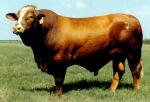
|
Simbrah
|
|
An experiment combining Simmental with Brahman that began in the pastures of a few dedicated cattlemen in the late 1960s has evolved logically into the breed called Simbrah. The Brahman or Zebu, the most numerous cattle type on earth, contributes heat and insect tolerance, hardiness and excellent foraging ability, as well as maternal calving ease and longevity. |
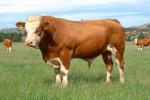
|
Simmental
|
|
Simmental can be traced to the Bernese Oberland, and were known as early as the Middle Ages as large, spotted cattle. From here, the 'Simmentals' spread into western and northern Switzerland. |
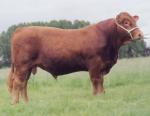
|
South Devon
|
|
South Devon have existed in south-west England for about 400 years. They are believed to have evolved from the large red cattle of Normandy which were imported to England at the time of the Norman invasion. Over 100 years of selection for performance have given the South Devon its outstanding qualities of beef and maternal characteristics. |
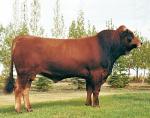
|
Tarentaise
|
|
The Tarentaise breed's home is in the rugged Savoie region of France. In France, no other cattle graze where the Tarentaise graze. Charolais, Maine-Anjou and Limousin are raised in Basin regions, where the land is more lush. Salers are native to a mountainous region, but it is not as mountainous as the home of the Tarentaise. |
|
|